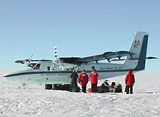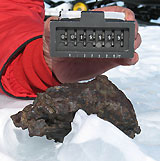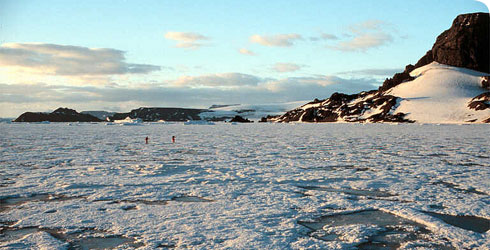Collecting meteorites in Antarctica
Interview with Sara Russell, Head of the Museum's Mineral and Planetary Sciences Division. Prof Russell has spent three summers collecting meteorites in Antarctica. Find out what is involved.
Why were you hunting for meteorites in Antarctica?
Antarctica is the best place in the world to find meteorites. Ninety per cent of all meteorites found have come from Antarctica. This is because the cold, dry Antarctic weather conditions preserve meteorites well and they are also easy to spot on the ice.
Who organised the expeditions?
The expedition is sponsored by the National Science Foundation, Smithsonian and the National Space Centre and takes place every year. They ask for volunteers who can identify meteorites and volunteers come from all over the world.
Why are meteorites so interesting?
Most meteorites are from asteroids that come from the early solar system and we can use them to find out what the Earth was made from. Martian meteorites are special because we don't have any Martian rocks from any of the missions to Mars.
How did you get to Antarctica?

About to start the meteorite search
First, I flew to Christchurch in New Zealand where I waited for the Hercules flight to Antarctica. I spent a week at McMurdo, which is a large research station in Antarctica. Then I flew out to the campsite.
Where did you camp?
We camped in areas near mountains as this is where meteorites are most often found. When a glacier collides with a mountain, rock and ice is exposed and is further eroded by strong winds, revealing many meteorites at the surface.
How did you look for meteorites?
A group of us line up and search up and down an area, either walking or on a snowmobile. Sometimes we find lots and it's a bit like being on an Easter egg hunt.
How can you tell the difference between a meteorite and a normal rock?

Collecting meteorites in Antarctica © Ralph Harvey
I have to get up close. When a meteorite comes through the atmosphere the edges get smoothed. The surface melts and goes shiny. If the meteorite is chipped, you can see inside and it looks different to normal rocks.
What do you do when you find one?
We mark the meteorite’s position and write a description. If we touch the meteorite, we will contaminate it, so we use sterilised tongs to put it into a sterilised bag.
What do you enjoy most about the expeditions?
One highlight was finding a meteorite from the moon. Most come from asteroids and so a lunar one is rare. It is really distinctive and we could tell straight away.

